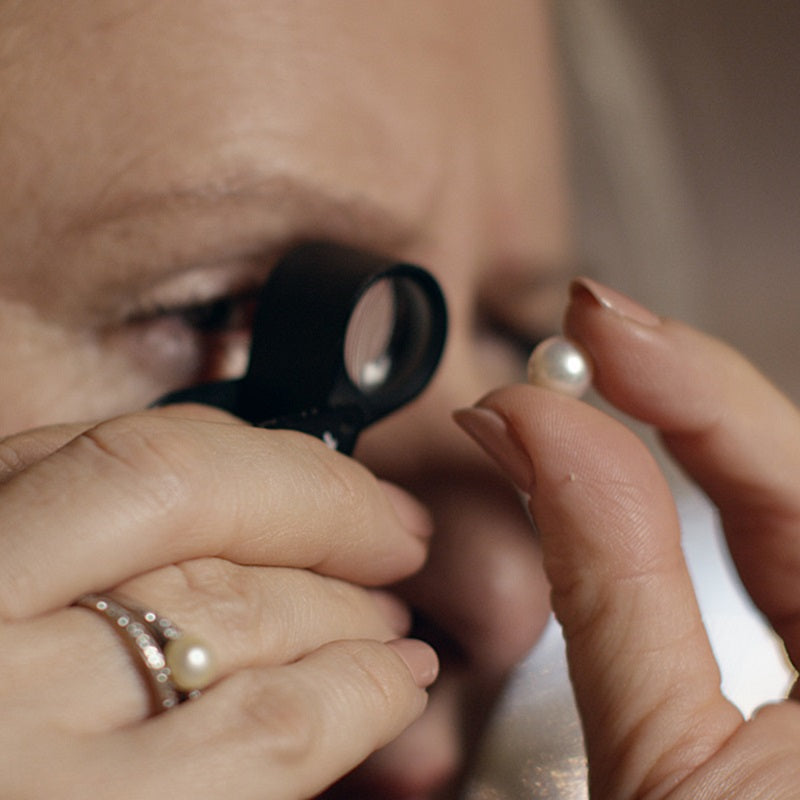
Pearls account for some of the most beautiful jewellery the world has to offer. This has been the case for hundreds of years. But what exactly is a pearl? More specifically, how do they become the beautiful gems we see today?
Read on as we explore what makes a pearl, a pearl.
How it all begins
Pearls are the result of self-defence by a mollusc (an oyster or mussel). This reaction starts when the mollusc covers an intruder with epithelial cells, which form a pearl sac around the offending object. In turn, these cells deposit concentric layers of nacre around the intruder and – layer by layer – form a pearl. If the mollusc does not react in this way, quite simply, it will die.

What is nacre?
Nacre is made up of calcium carbonate in the shape of tiny crystals called Aragonite. The Aragonite crystals are held together with a glue-like protein called Conchiolin. Our teeth are also made of calcium carbonate. However, the protein that holds our teeth together is stronger hence why ‘testing’ pearls against teeth is not only unhygienic, but totally undesirable as teeth could scratch the pearl.

How do epithelial cells work?
Epithelial cells produce nacre and are therefore essential to pearl formation. They are found in a special tissue called the mantle which starts at the hinge of the mollusc. As seen in the photograph shown, nacre grows not only on pearls but also as mother of pearl on the interior of the shell. Nacre layers within the shell of the mollusc act as a protective shield against the outside world. The only difference between pearls and mother of pearl is that the layers of a pearl are concentric while those in mother of pearl are flat or straight.

So, what about lustre?
Nacre layers play a vital role in a pearl's lustre. Nacre layers are very thin, translucent and reflect light, which creates the pearl’s distinctive lustre. Generally, the thicker the nacre with regular, thin and translucent layers, the finer the lustre will be on the pearl. In other words, lustre is caused by the reflection of light on the surface of the pearl and the refraction of light as it passes through the layers of nacre. This effect appears to make the pearl glow from within, as show in the diagram below.

Do pearls come from oysters?
The majority of people call pearl-bearing shellfish ‘oysters’, which is unlikely to change any time soon. However, for the most part, seawater pearl-bearing molluscs belong to the Pintadine family, a different type of mollusc family to that of the oysters we eat.
Within the Pintadine family, there are seven pearl-producing shellfish. Unlike their edible sedentary namesakes, the Pintadines are not edible and are mobile from one generation to another.
The mobility of the Pintadine shellfish is due to their reproductive cycle, as they can change gender from one season to another. When conditions are right, one shellfish releases spermatozoa into the water, which begins a chain reaction on all other pearl producing Pintadines in the area.
They release eggs and spermatozoa into the water, which are mixed at the mercy of the currents, and larvae are formed. The Larva propels itself with a small foot in the water and grows into spat (infant oyster). At 45 days, it is ½ inch long and ready to attach itself to a suitable growing spot with plenty of light, food and warmth.


As for freshwater pearls, the majority of these are produced by Unionides. These are bivalve shellfish, normally referred to as mussels or mulettes. They too are mobile and mainly inedible.
The mobility of pearl-producing mussels is also due to their reproductive cycle. In this case, the fertilised egg enters the gills of a fish and feeds off the fish, turning into larva. When the larva has been in the host fish for about two months and the fish reaches a particularly suitable stretch of water, the larva disengages from the fish and settles.

The end result – stunning pearls
With nature working so hard to produce each unique pearl, it’s no wonder that the end result makes such breath-taking jewellery.
At Coleman Douglas Pearls, we’re dedicated to helping people make the most of nature’s beauty by matching them with pearl jewellery rich in lustre, where light refracting off the layers of nacre will light up your complexion for years to come. Feel beautifully confident in perfectly matched pearls.
To find out more or arrange a consultation, please don’t hesitate to get in touch with us today.



















